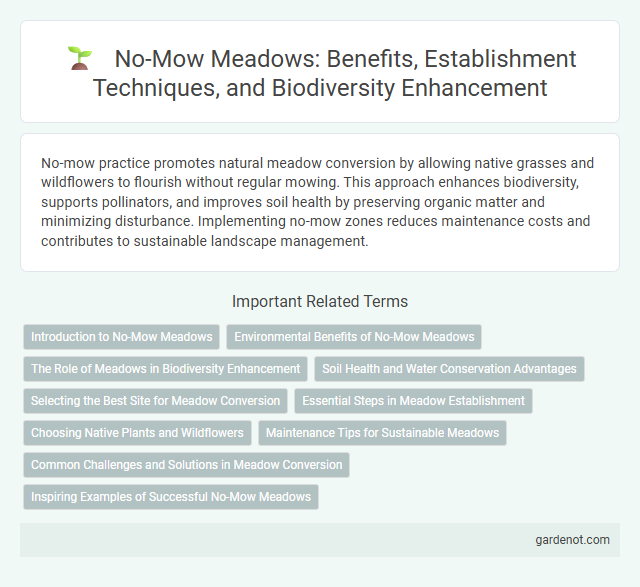No-mow practice promotes natural meadow conversion by allowing native grasses and wildflowers to flourish without regular mowing. This approach enhances biodiversity, supports pollinators, and improves soil health by preserving organic matter and minimizing disturbance. Implementing no-mow zones reduces maintenance costs and contributes to sustainable landscape management.
Introduction to No-Mow Meadows
No-mow meadows offer an eco-friendly alternative to traditional lawns by allowing native grasses and wildflowers to grow naturally, supporting pollinators and enhancing biodiversity. This practice reduces the need for watering, fertilizing, and mowing, lowering maintenance costs and carbon emissions. Establishing no-mow meadows involves selecting appropriate native species and managing growth to maintain a balanced ecosystem.
Environmental Benefits of No-Mow Meadows
No-mow meadows support biodiversity by providing habitats for pollinators, birds, and small mammals, enhancing local ecosystems. This practice reduces soil erosion and improves water retention, contributing to healthier landscapes and groundwater replenishment. Eliminating regular mowing lowers carbon emissions and noise pollution, promoting a more sustainable and eco-friendly environment.
The Role of Meadows in Biodiversity Enhancement
No-mow meadow conversion significantly boosts biodiversity by providing diverse habitats for pollinators, birds, and small mammals, supporting a wide range of native plant species. This practice enhances soil health and promotes ecological balance by reducing chemical inputs and preserving natural nutrient cycles. Meadows serve as vital ecological corridors, facilitating species movement and genetic exchange across fragmented landscapes.
Soil Health and Water Conservation Advantages
No-mow practices in meadow conversion enhance soil health by reducing soil compaction and increasing organic matter, which boosts microbial activity and nutrient cycling. This approach improves water infiltration and retention, minimizing runoff and erosion while conserving valuable water resources. Establishing diverse deep-rooted native plants supports long-term soil structure and sustains moisture levels, promoting ecosystem resilience.
Selecting the Best Site for Meadow Conversion
Selecting the best site for meadow conversion involves assessing soil quality, sunlight exposure, and drainage to ensure optimal plant growth and biodiversity. Areas with well-drained, nutrient-poor soils and full sun exposure typically support native wildflowers and grasses that thrive in no-mow environments. Avoid sites prone to flooding or heavy shading, as these conditions hinder meadow establishment and long-term sustainability.
Essential Steps in Meadow Establishment
Implementing a no-mow practice is crucial in meadow conversion by allowing native grasses and wildflowers to establish without disturbance, promoting biodiversity and soil health. Essential steps include site preparation through minimal soil disturbance, selecting a suitable seed mix of native species adapted to local conditions, and scheduling mowing only after plants set seed, typically late in the growing season. Monitoring and adaptive management ensure the meadow develops resilience and supports diverse wildlife over time.
Choosing Native Plants and Wildflowers
Selecting native plants and wildflowers for a no-mow meadow conversion enhances local biodiversity by providing essential habitats for pollinators like bees and butterflies. Native species are well-adapted to the local climate and soil, reducing maintenance and water needs while promoting ecological balance. Integrating a diverse mix of perennials, grasses, and wildflowers creates a resilient ecosystem that supports wildlife and improves soil health.
Maintenance Tips for Sustainable Meadows
No-mow practices enhance biodiversity and reduce maintenance costs by limiting frequent mowing to promote native plant growth. Maintaining sustainable meadows involves seasonal mowing only once or twice per year to prevent woody plant encroachment and encourage wildflower diversity. Regularly removing cut vegetation prevents nutrient buildup, supporting soil health and long-term meadow vitality.
Common Challenges and Solutions in Meadow Conversion
No-mow practices in meadow conversion often face challenges such as invasive weed encroachment and uneven plant establishment. Addressing these issues requires regular monitoring and selective removal of invasive species to maintain native biodiversity. Soil preparation techniques, like minimal disturbance and organic mulch application, enhance seed germination and promote healthy meadow growth.
Inspiring Examples of Successful No-Mow Meadows
No-mow meadows, such as the renowned High Line in New York City and the Boston Nature Center, showcase the ecological and aesthetic benefits of reduced mowing practices. These successful no-mow sites demonstrate increased biodiversity, improved pollinator habitats, and significant carbon sequestration. The transformation of urban and suburban lawns into vibrant no-mow meadows inspires sustainable land management and cost-effective ecological restoration.
No-mow practice Infographic

 gardenot.com
gardenot.com